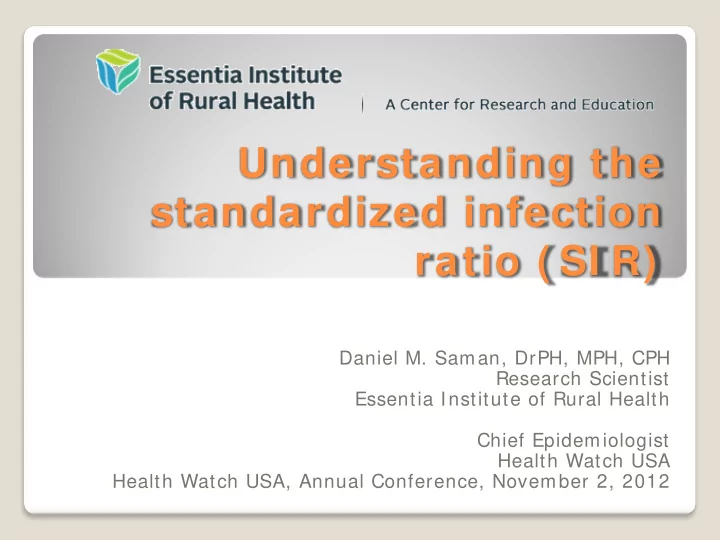

Understanding the standardized infection ratio ( SI R) Daniel M. Saman, DrPH, MPH, CPH Research Scientist Essentia Institute of Rural Health Chief Epidemiologist Health Watch USA Health Watch USA, Annual Conference, November 2, 2012
Standardized infection ratio is a summary measure used by CDC to track HAIs at national, state, or facility level over time. Hospital Compare website SI R
The SIR is calculated by dividing the number of observed infections by the number of expected infections. The number of expected infections, in the context of statistical prediction, is calculated using CLABSI rates from a standard population during a baseline time period. The baseline period for CLABSI SIR calculations is 2006-2008 NHSN aggregate as reported in the NHSN Report. Therefore SIRs are calculated for CLABSI data in 2009 and forward. NOTE: The SIR will be calculated only if the number of expected HAIs (numExp) is ≥ 1. When the numExp is <1, this indicates that, based on the NHSN aggregate rates, the central line-day count in your facility or location is too low to calculate a precise SIR and comparative statistics. SI R
The CLABSI SIRs are adjusted for patient mix by type of patient care location, hospital affiliation with a medical school, and bed size of the patient care location. The predicted number is an estimated number of HAIs based on infections reported to NHSN during January 2006– December 2008.
KY Hospitals > 5000 central line days CLABSI Central Observed Predicted CLABSI SIR (Obs / Rate (per 1000 Hospital Name City County Name Line Days Cases cases Predicted) line days) SAINT JOSEPH HOSPITAL LEXINGTON FAYETTE 9414 2 15.222 0.13 0.21 BAPTIST HOSPITAL EAST LOUISVILLE JEFFERSON 5619 2 8.429 0.24 0.36 ST ELIZABETH MEDICAL CENTER NORTH COVINGTON KENTON 6515 4 12.429 0.32 0.61 KING'S DAUGHTERS' MEDICAL CENTER ASHLAND BOYD 5453 3 8.412 0.36 0.55 CENTRAL BAPTIST HOSPITAL LEXINGTON FAYETTE 6728 5 10.448 0.48 0.74 JEWISH HOSPITAL & ST MARY'S HEALTHCARE LOUISVILLE JEFFERSON 11856 20 22.672 0.88 1.69 UNIVERSITY OF KENTUCKY HOSPITAL LEXINGTON FAYETTE 16274 40 42.957 0.93 2.46 UNIVERSITY OF LOUISVILLE HOSPITAL LOUISVILLE JEFFERSON 8915 22 22.848 0.96 2.47 NORTON HOSPITALS, INC LOUISVILLE JEFFERSON 30814 81 63.626 1.27 2.63 Only King’s Daughters is for profit Large KY Hospitals
National hospitals CLABSI Central Line Observed Predicted CLABSI SIR (Obs / Rate (per 1000 Hospital Hospital Name City State Days Cases Cases Predicted) line days) Type SAINT JOSEPH HOSPITAL Lexington KY 9414 2 15.222 0.13 0.21 NonProfit WEST VIRGINIA UNIVERSITY HOSPITALS Morgantown WV 9580 1 22.768 0.04 0.10 NonProfit JPS HEALTH NETWORK Fort Worth TX 10026 3 22.514 0.13 0.30 Govt MORTON PLANT HOSPITAL Clearwater FL 10299 1 16.299 0.06 0.10 NonProfit MOBILE INFIRMARY Waynesboro GA 10321 2 22.58 0.09 0.19 NonProfit ST DAVIDS MEDICAL CENTER Austin TX 10518 0 21.724 0 0.00 ForProfit MERCY GENERAL HOSPITAL Sacramento CA 10811 0 18.092 0 0.00 NonProfit HARPER UNIVERSITY HOSPITAL Detroit MI 10865 3 25.73 0.12 0.28 ForProfit ST LUKES HOSPITAL OF KANSAS CITY Kansas City MO 11064 3 24.744 0.12 0.27 Govt DESERT SPRINGS HOSPITAL Las Vegas NV 11922 1 17.883 0.06 0.08 ForProfit THE QUEENS MEDICAL CENTER Honolulu HI 12067 0 25.133 0 0.00 NonProfit RIVERSIDE METHODIST HOSPITAL Columbus OH 13566 3 28.195 0.11 0.22 NonProfit CEDARS-SINAI MEDICAL CENTER Los Angeles CA 22029 3 45.981 0.06 0.14 NonProfit Top Perform ers, Low est SI R and Highest Line Days
Most states (> 97% ) are at a reduced risk Facility, med school affiliation, adjustments may not be necessary ◦ Apparently correcting for inherently increased risk Problem s w ith SI R
The peak of the histogram is at SIR= 0.35 We believe this is an “obtainable” SIR If a majority of hospitals can achieve this, then the “baseline” of 1.0 is set too high; baseline should be set at peak, 0.35 Solutions
The curve’s peak is more reflective of high-performing facilities Factors used for risk-adjustment should relate to patient population characteristics, not facility type, or size Just as universities are ranked together in groups of facility type, we recommend that healthcare facilities of similar types be compared side-by-side Conclusions
Recommend
More recommend